实验 2 类和继承
1、设计一个名为 figure 的图形软件包(package)。包中包含三角形、矩形、圆三个类。要
求:(1)每个类都要构造方法并为成员设置 get 和 set 方法;(2)每个类都要有计算周
长和面积的成员方法;(3)完成该软件包后的编码后,在另一个包的含有 main 方法的类
中编写代码,分别使用图形软件包中的三个类,生成三个对象,并打印出其周长和面积。
代码如下:
package figure;
/*三角形类*/
public class Triangle {
private float length1 = 9;
private float length2 = 9;
private float length3 = 9;
public Triangle(int l1,int l2,int l3) {
this.setLength1(l1);
this.setLength2(l2);
this.setLength3(l3);
}
public void setLength1(float length1) {
this.length1 = length1;
}
public float getLength1() {
return length1;
}
public void setLength2(float length2) {
this.length2 = length2;
}
public float getLength2() {
return length2;
}
public void setLength3(float length3) {
this.length3 = length3;
}
public float getLength3() {
return length3;
}
public double getArea() {
double p=(length1+length2+length3)/2.0;
return Math.sqrt(p*(p-length1)*(p-length2)*(p-length3));
}
�
public double getC() {
return length1+length2+length3;
}
}
package figure;
/*矩形类*/
public class Rectangle {
private float width = 8;
private float length = 8;
public Rectangle(float w, float l) {
this.length = l;
this.width = w;
}
public void setWidth(float width) {
this.width = width;
}
public float getWidth() {
return width;
}
public void setLength(float length) {
this.length = length;
}
public float getLength() {
return length;
}
public double getArea() {
return length * width;
}
public double getC() {
return 2 * (length + width);
}
}
package figure;
/*矩形类*/
public class Circular {
private float len = 8;
public Circular(float r) {
�
this.len = r;
}
public void setRadio(float radio) {
this.len = radio;
}
public float getRadio() {
return len;
}
public double getArea() {
return Math.PI* Math.pow(len, 2);
}
public double getC() {
return 2 * Math.PI * len;
}
}
/*main 方法测试*/
package cn.edu.skd.javatest2;
import figure.*;
public class figure_test {
public static void main(String[] args) {
Triangle t = new Triangle(8, 8, 8);
System.out.println("三角形的面积" + t.getArea());
System.out.println("三角形的周长" + t.getC());
Rectangle r = new Rectangle(8, 8);
System.out.println("矩形的面积" + r.getArea());
System.out.println("矩形的周长" + r.getC());
Circular c = new Circular(8);
System.out.println("圆形的面积" + c.getArea());
System.out.println("圆形的周长" + c.getC());
}
}
运行结果如下:
2、编写类 Factorial,为其添加两个静态方法(方法名自定义)。其中一个使用递归计算 n
的阶乘,一个使用非递归计算 n 的阶乘。构造 main 方法进行测试。
代码如下:
package cn.edu.skd.javatest2;
�
public class Factorial {
public static void
main(String[] args) {
int n = 10;
System.out.println("递归求解:10!=" + fac1(n));
System.out.println("非递归求解:10!=" + fac2(n));
}
/* 递归 */
public static long fac1(int n) {
if (n < 0)
return -1;
else if (n == 0 || n == 1)
return 1;
else
return n * fac1(n - 1);
}
/* 非递归 */
public static long fac2(int n) {
int sum = 1;
if (n < 0)
return -1;
else if (n == 0 || n == 1)
sum = 1;
else
for (int i = 1; i <= n; i++) {
sum *= i;
}
return sum;
}
}
运行结果如下:
3、按照要求使用 Java 进行编码。
1) 设计一个教师类 Teacher,属性有编号(no)、姓名(name)、年龄(age)、所属学
院(seminary),为这些属性设置相应的 get 和 set 方法;
2) 为 Teacher 类添加方法 equals;(当两个教师对象的 no 相同时返回 true)
3) 为 Teacher 类添加方法 toString,通过该方法可以返回“编号为**、姓名为**、
�
年龄为**的**学院老师”形式的字符串。
4) 构造 main 方法进行测试。
代码如下:
package cn.edu.skd.javatest2;
public class Teach {
main(String[] args) {
public static void
Teacher t1 = new Teacher("001", "戴宗", 18, "信息");
Teacher t2 = new Teacher("003", "宋江", 48, "信息");
Teacher t3 = new Teacher("003", "吴用", 39, "信息");
Teacher t4 = new Teacher("004", "林冲", 42, "信息");
if (t2.equals(t3)) {
System.out.println(t2.getName() + "老师和" + t3.getName() + "
老师相同");
} else {
System.out.println(t2.getName() + "老师和" + t3.getName() + "
老师不相同");
}
if (t2.equals(t4)) {
System.out.println(t2.getName() + "老师和" + t4.getName() + "
老师相同");
} else {
System.out.println(t2.getName() + "老师和" + t4.getName() + "老
师不相同");
}
System.out.println(t1.toString());
}
}
class Teacher {
private String no;// 编号
private String name;// 姓名
private int age;// 年龄
private String seminary;// 所属院校
public Teacher(String no, String name, int age, String seminary) {
this.no = no;
this.name = name;
this.age = age;
this.seminary = seminary;
}
public void setNo(String no) {
this.no = no;
}
public String getNo() {
�
return no;
}
public void setName(String name) {
this.name = name;
}
public String getName() {
return name;
}
public void setAge(int age) {
this.age = age;
}
public int getAge() {
return age;
}
public void setSeminary(String seminary) {
this.seminary = seminary;
}
public String getSeminary() {
return seminary;
}
public boolean equals(Teacher t) {
if (this.no.toString().trim().equals(t.no.toString().trim()))
return true;
else
return false;
}
public String toString() {
return "编号为" + this.no + "、姓名为" + this.name + "、年龄为" +
this.age + "的" + this.seminary + "的老师";
}
}
运行结果如下:
4、设计一个带表头的单链表(链表中的元素属于同一类型对象,但对象的类型可以随意),
提供以下操作:(1)insert:在某个位置插入对象;(2)delete:在某个位置删除对象;
(3)delete:删除链表中与 x 相同的元素;(4)size:返回当前链表中对象的个数;(5)
isEmpty:判断链表是否为空;(6)traverse:遍历链表,打印出所有的元素;(7)getData:
取得某个位置的对象。构造 main 函数进行测试。
代码如下:
package cn.edu.skd.javatest2;
�
public class LinkedList {
private Node head;
private int count;
public LinkedList() {
head = new Node(null);/* 初始化头结点 */
count = 0;
}
/* 在某个位置插入对象; */
public boolean insert(int i, Object o) {
if (i > count || i < 0) {
System.out.println("插入位置错误");
return false;
} else if (i == 0) {
head.setNext(new Node(o, head.getNext()));
count++;
return true;
} else {
Node n = head.getNext();
int j = 0;
/* n 指向要插入位置的前一个位置 */
while ((n != null) && j < i - 1) {
n = n.getNext();
j++;
}
n.setNext(new Node(o, n.getNext()));
count++;
return true;
}
}
/* 在某个位置删除对象 */
public Object delete(int i) {
if (count == 0) {
return null;
}
if (i < 0 || i > count - 1) {
return null;
} else if (i == 0) {/* 删除第一个结点 */
/* 记录删除的对象,用于返回值 */
Object o = head.getNext().getData();
head.setNext(head.getNext().getNext());
�
count--;
return o;
} else {/* 删除其他结点 */
Node h = head;/* 记录头结点 */
int j = 0;
while ((h.getNext() != null) && j < i) {
h = h.getNext();/* h 指向要删除结点的前一个结点 */
j++;
}
Object o = h.getNext().getData();
h.setNext(h.getNext().getNext());
count--;
return o;
}
}
/* 删除链表中与 o 相同的元素 */
public Object delete(Object o) {
if (this.head == null || this.head.getNext() == null) {
return null;
}
Node n = head.getNext();/* n 指向第一个结点 */
Node p = head;/* 记录 n 指向结点的前一个结点 */
while (n != null) {
if (n.getData().equals(o)) {
p.setNext(n.getNext());
count--;
return n.getData();
} else {
p = n;/* 记录 n 指向结点的前一个结点 */
n = n.getNext();/* n 指向下一个结点 */
}
}
return null;/* 没有相同元素 */
}
/* 返回当前链表中对象的个数 */
public int size() {
return count;
}
/* 判断链表是否为空 */
public boolean isEmpty() {
return count == 0 ? true : false;
�
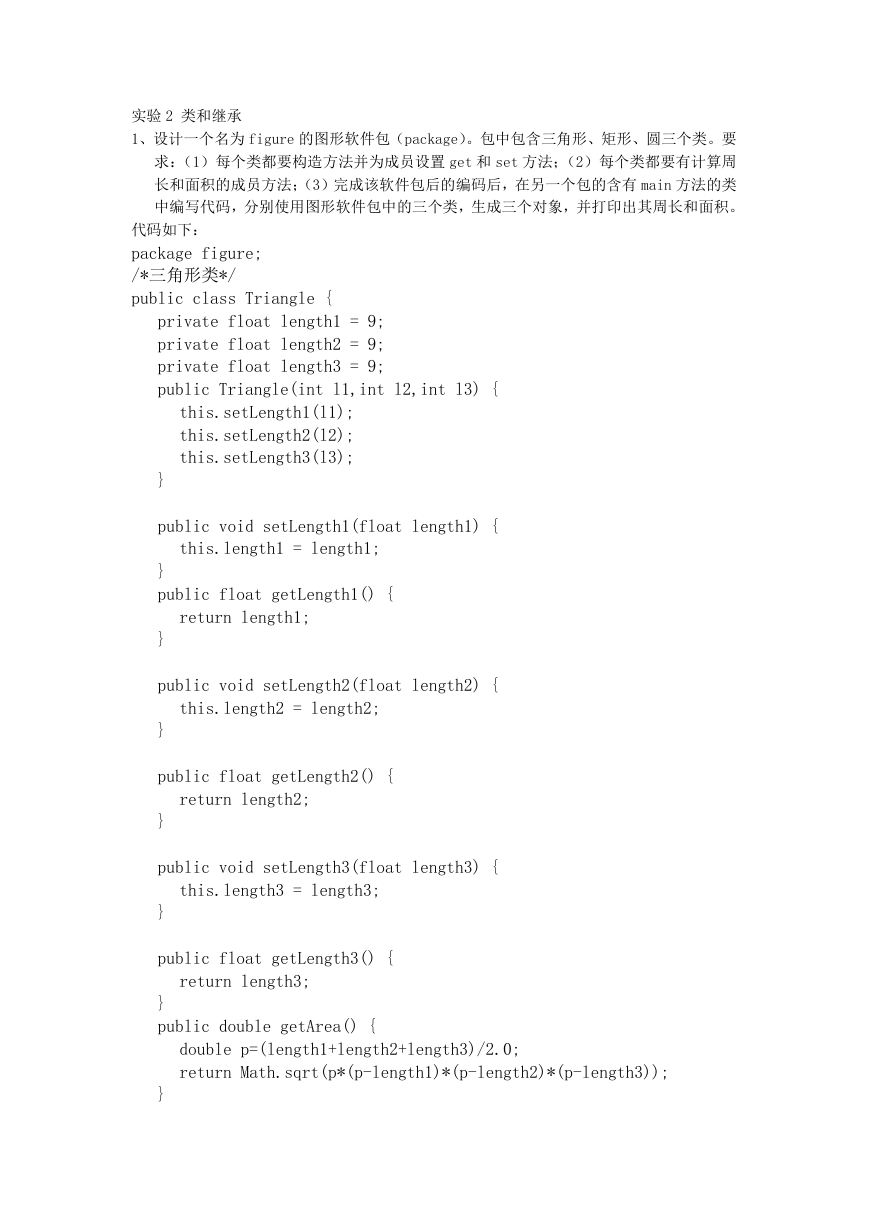
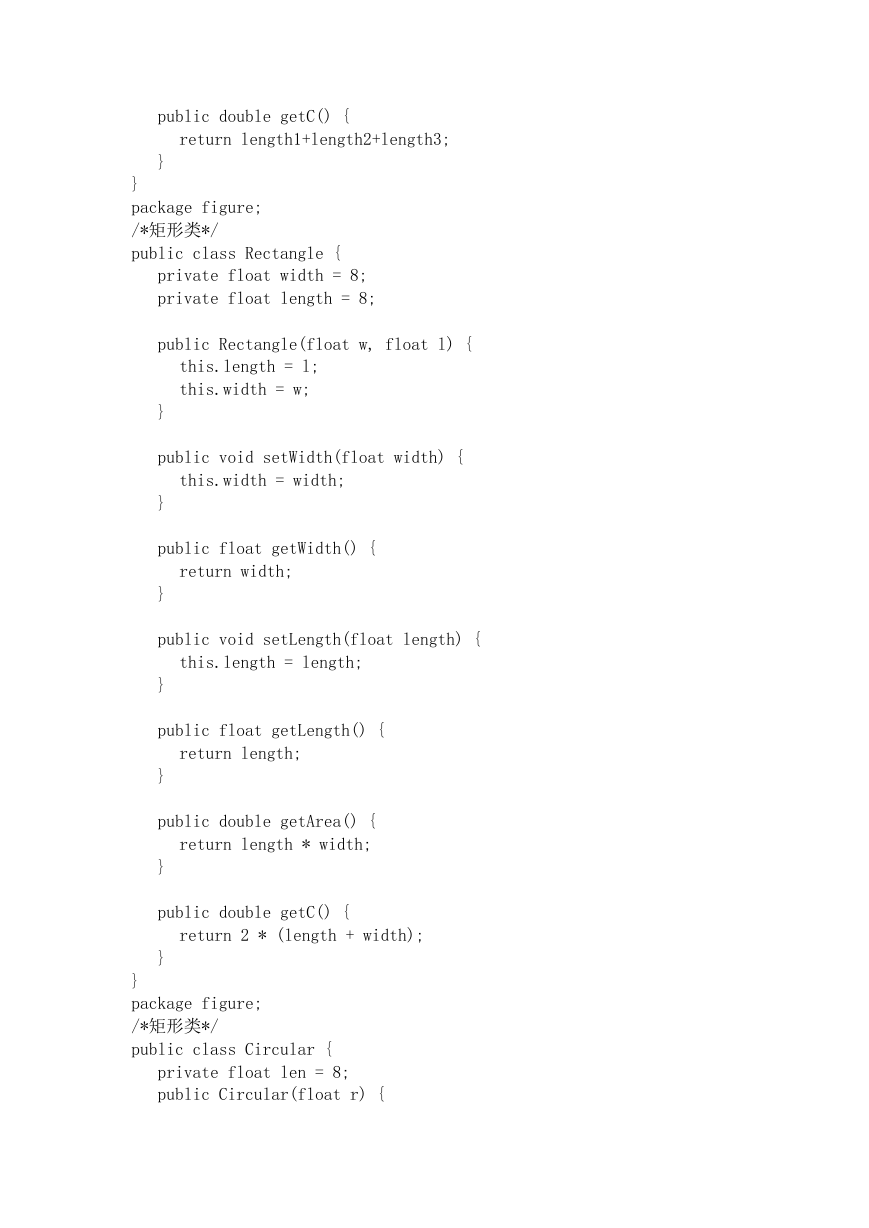
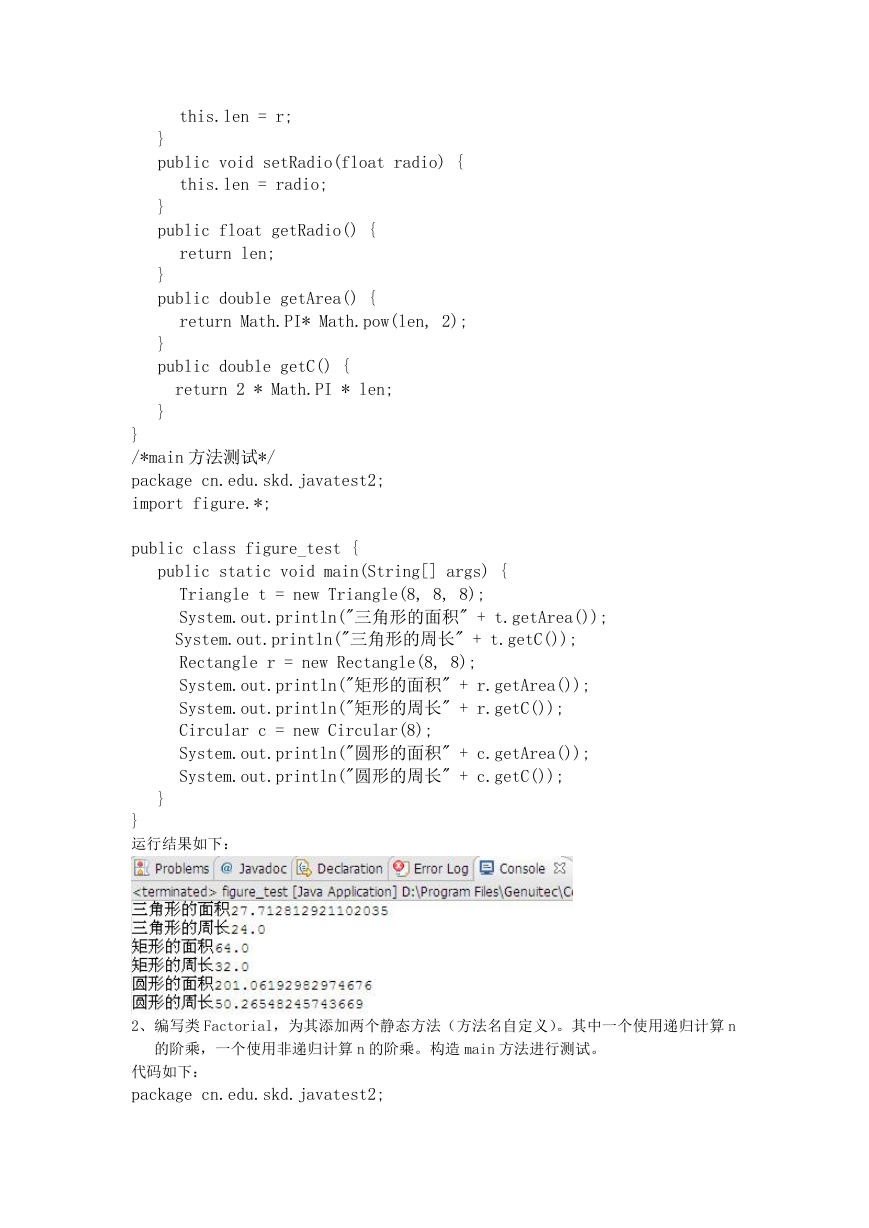
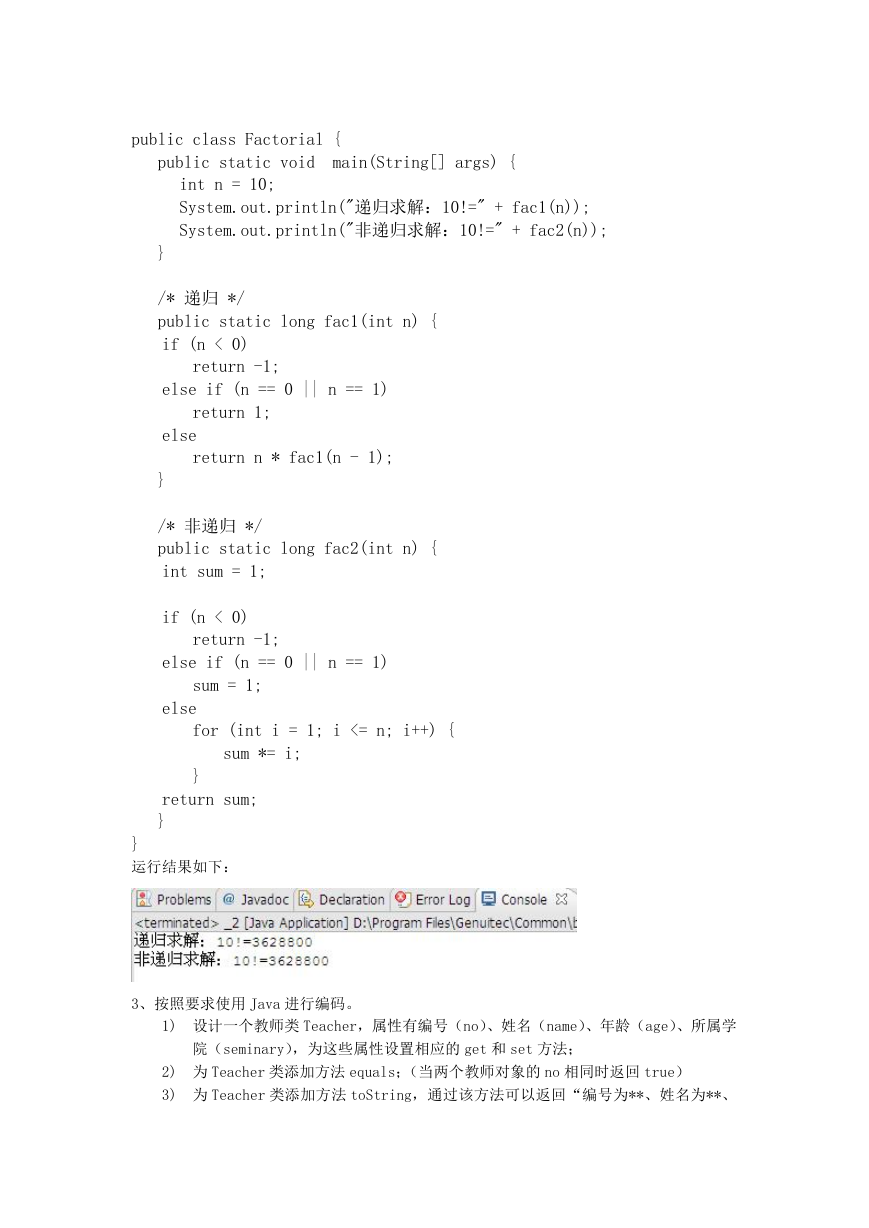
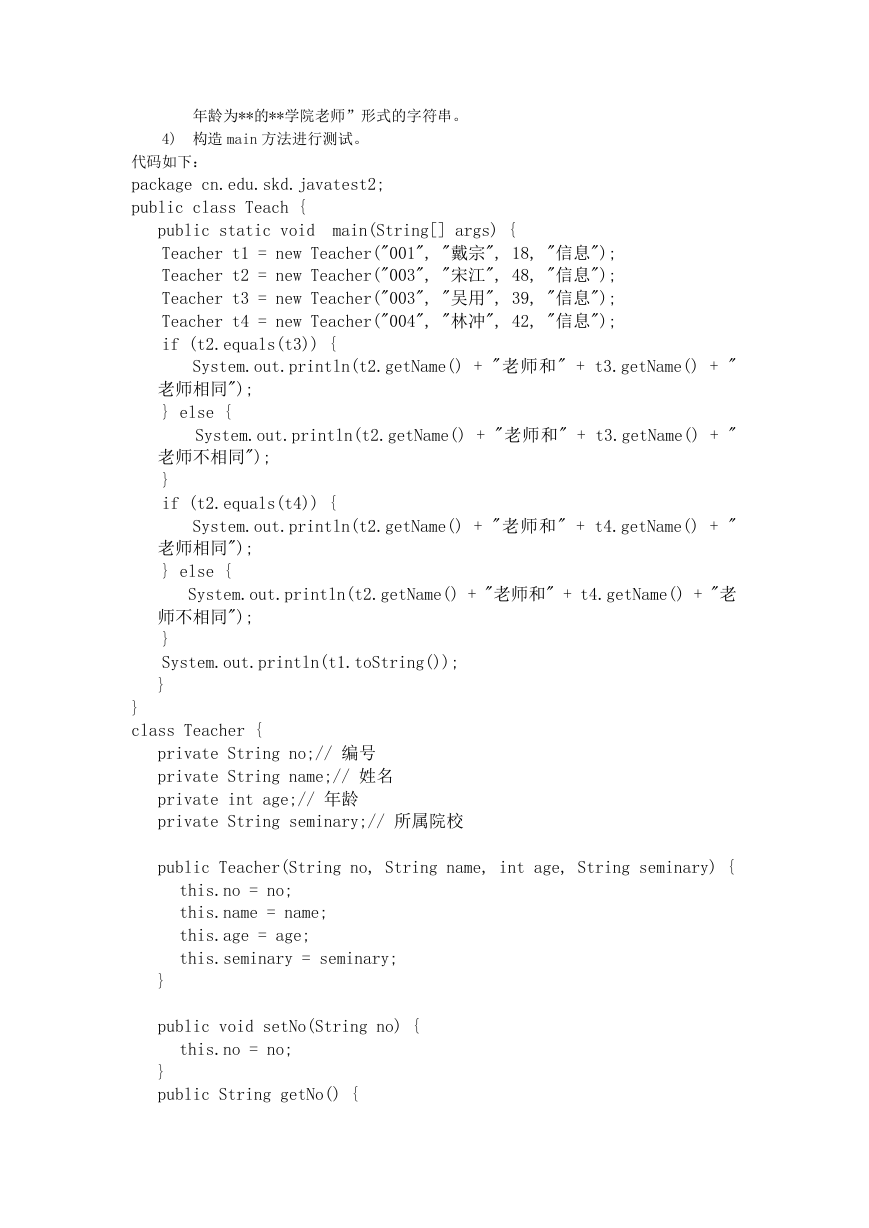
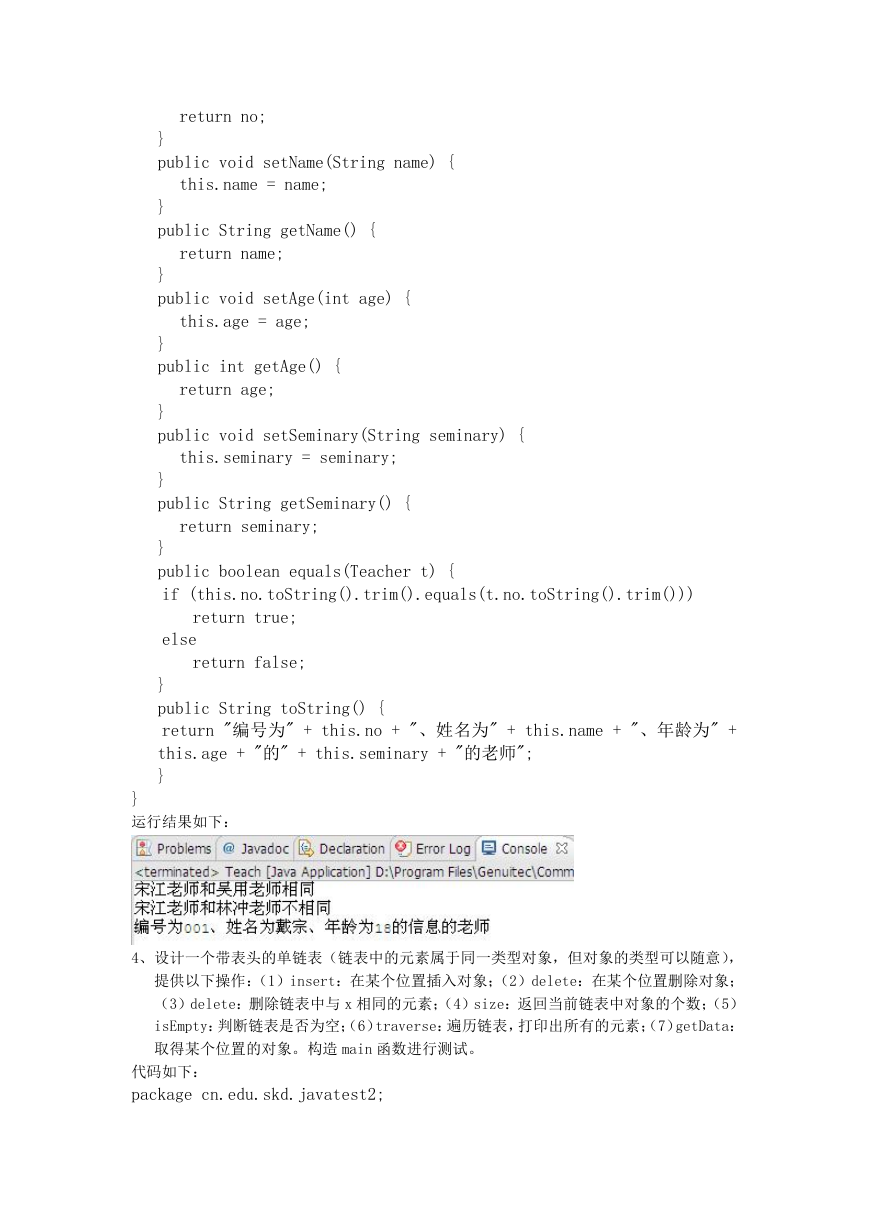
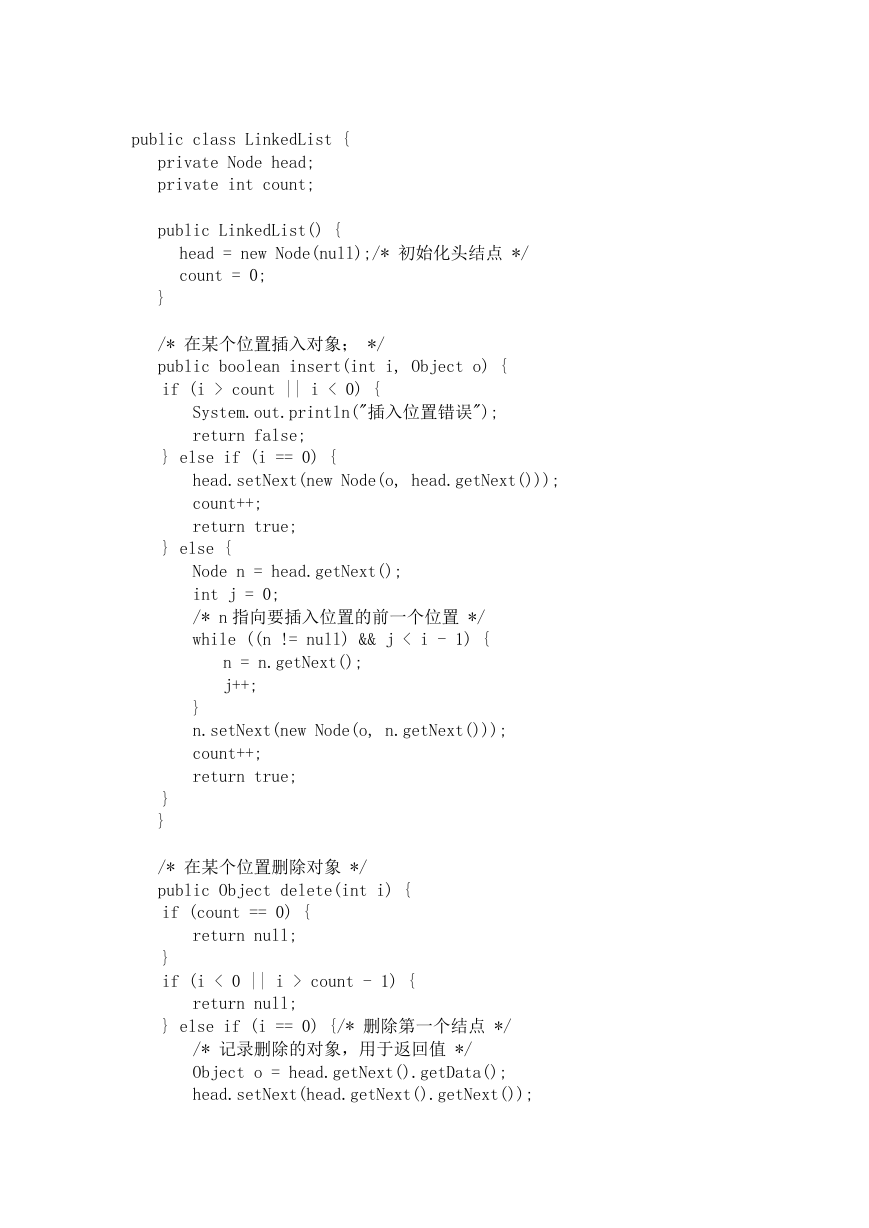
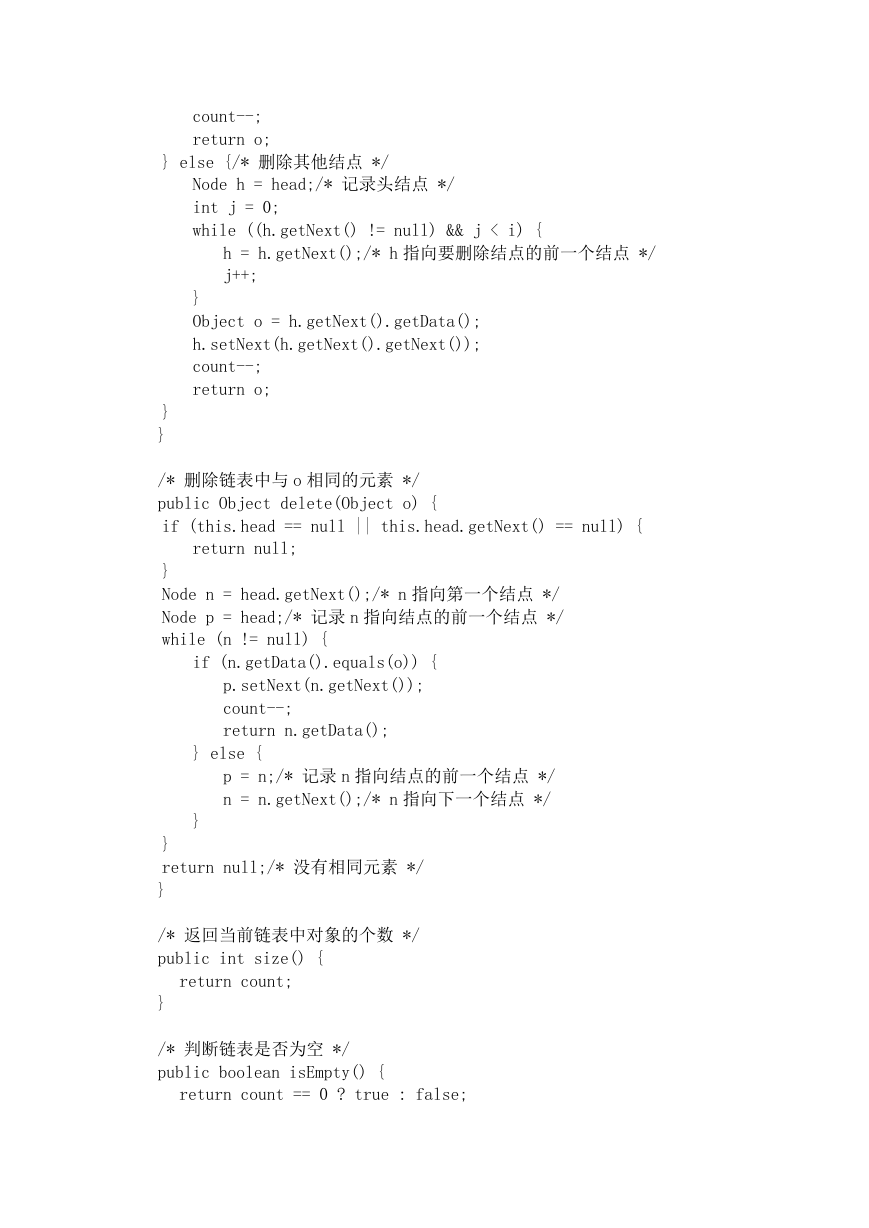








 2023年江西萍乡中考道德与法治真题及答案.doc
2023年江西萍乡中考道德与法治真题及答案.doc 2012年重庆南川中考生物真题及答案.doc
2012年重庆南川中考生物真题及答案.doc 2013年江西师范大学地理学综合及文艺理论基础考研真题.doc
2013年江西师范大学地理学综合及文艺理论基础考研真题.doc 2020年四川甘孜小升初语文真题及答案I卷.doc
2020年四川甘孜小升初语文真题及答案I卷.doc 2020年注册岩土工程师专业基础考试真题及答案.doc
2020年注册岩土工程师专业基础考试真题及答案.doc 2023-2024学年福建省厦门市九年级上学期数学月考试题及答案.doc
2023-2024学年福建省厦门市九年级上学期数学月考试题及答案.doc 2021-2022学年辽宁省沈阳市大东区九年级上学期语文期末试题及答案.doc
2021-2022学年辽宁省沈阳市大东区九年级上学期语文期末试题及答案.doc 2022-2023学年北京东城区初三第一学期物理期末试卷及答案.doc
2022-2023学年北京东城区初三第一学期物理期末试卷及答案.doc 2018上半年江西教师资格初中地理学科知识与教学能力真题及答案.doc
2018上半年江西教师资格初中地理学科知识与教学能力真题及答案.doc 2012年河北国家公务员申论考试真题及答案-省级.doc
2012年河北国家公务员申论考试真题及答案-省级.doc 2020-2021学年江苏省扬州市江都区邵樊片九年级上学期数学第一次质量检测试题及答案.doc
2020-2021学年江苏省扬州市江都区邵樊片九年级上学期数学第一次质量检测试题及答案.doc 2022下半年黑龙江教师资格证中学综合素质真题及答案.doc
2022下半年黑龙江教师资格证中学综合素质真题及答案.doc